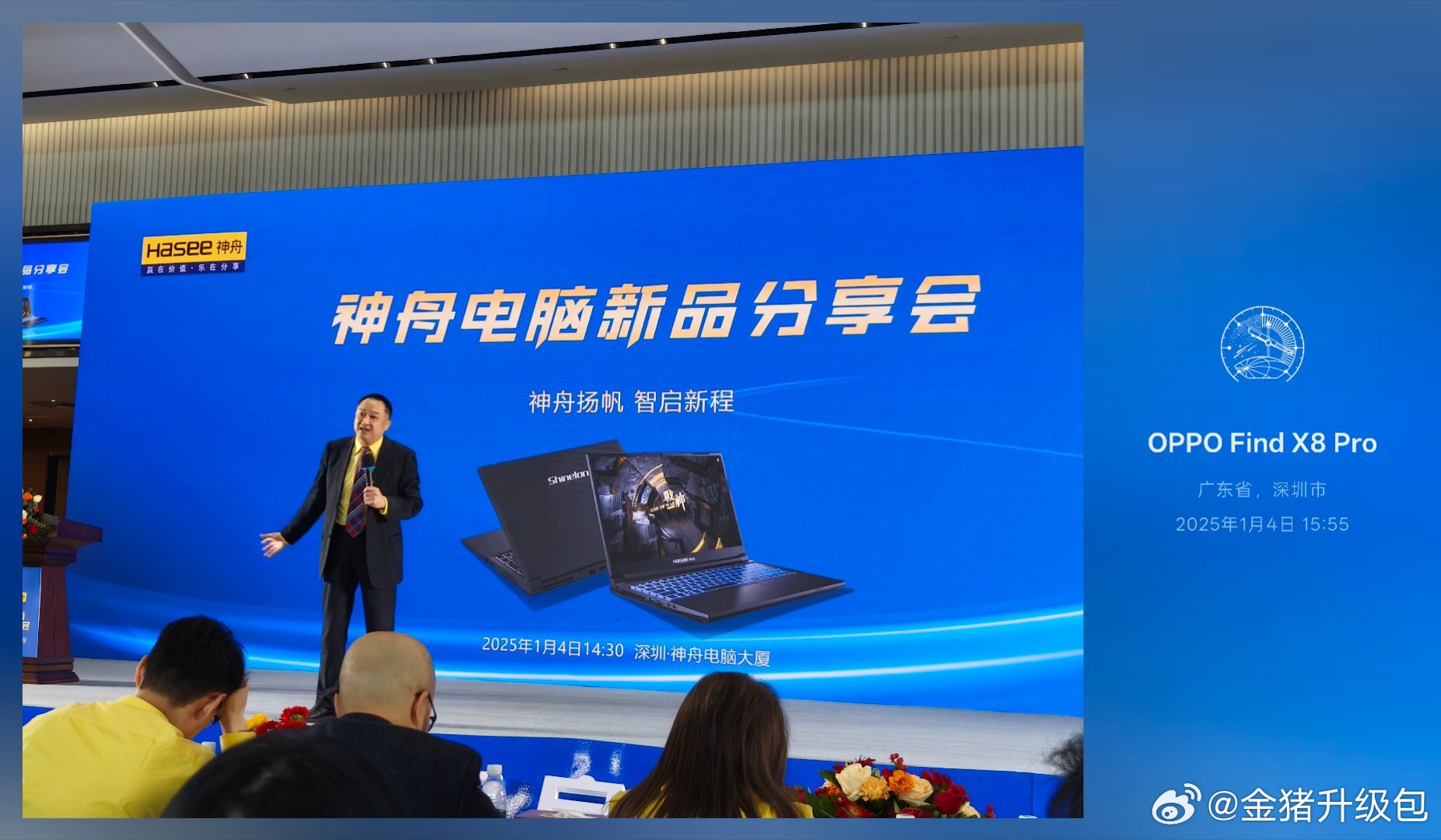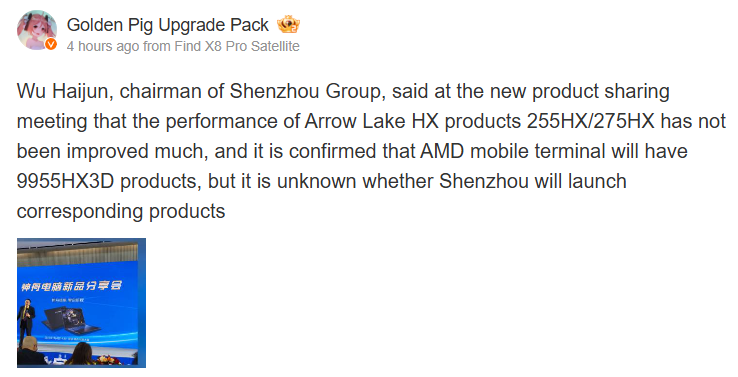Vendor claims Ryzen 9 9955HX3D with Zen 5 cores and 3D V-Cache is ready for launch — manufacturer also asserts Arrow Lake-HX CPUs offer minimal performance improvements

AMD is rumored to be working on a successor to its Dragon Range (Ryzen 7045HX) processor lineup, codenamed Fire Range. Wu Haijun, chairman of Hasee, a Chinese PC manufacturer, has reportedly confirmed that these upcoming CPUs will be branded per AMD's old naming scheme and further asserted the development of an X3D variant on mobile, namely the Ryzen 9 9955HX3D (via Golden Pig Upgrade Pack). In addition, the discussion also touched on Intel's Arrow Lake-HX processors, but the sentiment was not strictly positive.
AMD and Intel offer select processors employing desktop-grade silicon branded with the HX suffix at the high end. With Ryzen 7000, AMD introduced the Dragon Range series, featuring upwards of two CCDs and one IOD, distinct from other mobile counterparts, which are monolithic. These processors are designated for workstations or desktop replacements but suffer from poor battery life due to the multi-chiplet design. Likewise, Intel's HX-series processors are no different, with the latest iteration, Core Ultra 200HX or Arrow Lake HX, expected to debut at CES.
At a recent pre-launch product briefing, Wu Haijun, president and founder of Hasee Computer Company, shared essential details about AMD and Intel's forthcoming HX processors. Reportedly, AMD is porting its X3D or 3D V-Cache technology to mobile with Fire Range X3D.

However, Wu Haijun named the Ryzen 9 9955HX3D, an upcoming mobile CPU from AMD, after the Ryzen 9 7945HX3D. He didn't confirm whether Hasee products would feature this processor on their laptops. Interestingly, while AMD's Zen 5 mobile CPUs have adopted the new Ryzen AI 300 branding, the firm is reviving its old naming scheme for Fire Range.
On the other hand, Arrow Lake-HX was also a part of the discussion at the meeting. Per the report, Intel's 255HX and 275HX, alleged to be 20 and 24 core offerings, respectively, are not that impressive in performance. The exact definition of the word "performance" in this context is unclear, however, it is a known fact that Arrow Lake does not deliver many improvements; if any, over Raptor Lake when we consider raw performance.
Efficiency, on the contrary, is another topic. Arrow Lake-HX should theoretically outperform Raptor Lake-HX if both chips operate within a strict 45W power limit. Still, we'll leave Intel to fill out the extra details at its CES keynote.
Get Tom's Hardware's best news and in-depth reviews, straight to your inbox.

Hassam Nasir is a die-hard hardware enthusiast with years of experience as a tech editor and writer, focusing on detailed CPU comparisons and general hardware news. When he’s not working, you’ll find him bending tubes for his ever-evolving custom water-loop gaming rig or benchmarking the latest CPUs and GPUs just for fun.
-
NinoPino Reply
X3D parts are way more efficient than non-X3D CPUs, so imho it is a must-have, for peoples that need high performance in a portable form.newtechldtech said:X3D for laptops is not needed at all . the GPU is the bottleneck is laptops.
As pointed in the article, these CPUs are aimed at "desktop replacement", so the integrated GPU is not a big concern when 99% of have a discrete GPU. -
Mama Changa Reply
LOL, the Fire Range apu will have a very weak iGPU and is designed to be used with a dGPU, so X3D is very important for this apu.newtechldtech said:X3D for laptops is not needed at all . the GPU is the bottleneck is laptops. -
watzupken I find this is overkill for most people and also priced way out for most people to buy. Looking at just the normal Ryzen AI chips currently available, and they are already very expensive, so I can imagine how much AMD will charge for this.Reply -
abufrejoval Not sure you'd get an optimal gaming laptop out of these, because I'd have to concur that mobile dGPUs simply can't burn the Wattage of their desktop cousins. Perhaps more of a CUDA workstation, but these aren't mass market items. I wonder just how many of these chips AMD is selling...Reply
I got a Dragon Range Zen4 16-core variant as a mobile-on-desktop Mini-ITX board from Minisforum and it's a very reasonable µ-server in my case, but would also work rather well as a gaming rig.
They don't have X3D models available, which I might have grabbed, otherwise; I'm very happy with the 7950X3D desktop CPUs I also own.
In practical gaming the difference between those two isn't nearly as high as the reviews seem to indicate, some things like Flight Simulator (2020 and 2024) in VR just suck no matter what I throw at them (RTX 4090 included), most others are just good enough to enjoy with either one.
My main attraction was the price point (€500 for the mainboard including the 16-core Zen 4 CPU) and the fact that for a stationary system, it's rather low power and noise.
TDP can be configured somewhere between 100 and 35 Watts on that board, mine runs "unconstrained" and it will reach 100 Watts on Prime95 max-heat for the entire APU according to HWinfo, 130 Watts at the wall plug, yet a simple quiet 90mm fan will keep it cool and idle is between 20 and 30 Watts at the wall plug, much less than typical Zen desktop systems.
Perhaps their target is really more mobile workstations but once their successors are announced, they evidently sell at much more reasonable prices.
BTW: while the iGPU is weak in terms of 3D, it's really rather snappy for 2D and works like a charm in hybrid mode with older dGPUs. E.g. I was able to get 4k at 144Hz and HDR out of the iGPU pairing it with a GTX1080ti, which can't deliver anything beyond 60Hz at 4k on its own. And gaming performance didn't suffer nearly as much from that hybrid configuration as I'd have imagined.